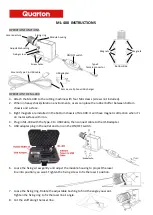
RESISTOMAT
®
Model 2302-V001
Page 18
Introduction &
applications
Description of functions
Brief guide
Operation
Calibration
Test and offset
instructions
RS232 data
output
Accessories and Circuit diagram
Operation
Figure 4: Measurement of contact resistances on switches
At this point, we would like to refer to our clamping devices Model 2381 and Model 2382
which are meant for operation in air and water respectively and ensure proper contact with
your samples.
Another possible connection shown below involves the measurement of contact resistances
on switches.
The occurrence of thermal e.m.fs in the voltage path must be prevented; this applies
particularly in the case of the smallest measurement ranges.
If all connections are made with copper or brass parts (not galvanized!), no major
falsifications can be expected.
Pole reversal in the current or voltage leads results in displays prefixed with a negative sign,
although this is purely a "cosmetic" error.
Shielding
Normally, measuring leads in laboratories are routed openly. This would only create
problems if heavy interference were generated, e.g. by varying magnetic fields.
If an experiment with unshielded leads does not proceed satisfactorily, it is advisable to
enclose the leads in seamless, grounded steel tubes where large distances are invloved.
50 Hz interference, which is present practically everywhere, is filtered out by the input circuit
of the RESISTOMAT
®
.
Signal lamp for line resistance (R
L
)
Located below the measurement terminals, this lamp comes on if the voltage drop in the
external current path reaches a critical value at which the current stabilization is no longer
effective. This indicates an excessively high line resistance R
L
or an interruption.
When this lamp is on, the measured values are incorrect!
+ U
- U
+ I
- I
















































